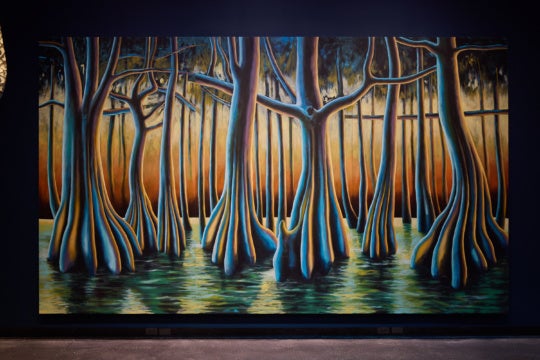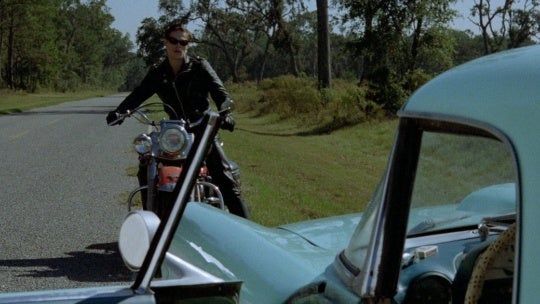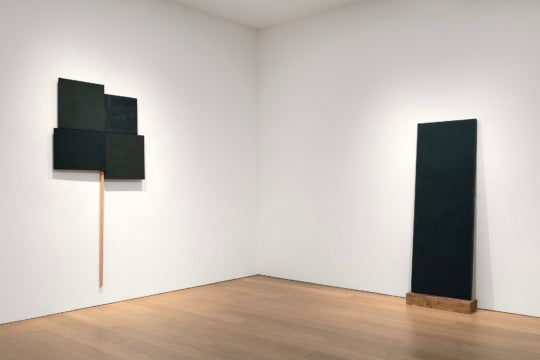
The second set of exhibitions at the recently opened Tif Sigfrids and Howard’s—two distinct galleries operating out of a shared, three-room space—brings the work of artists Charles Harlan, Eleanor Ray, and Ree Morton to Athens, GA. While the Harlan and Ray exhibitions are presented by gallerists Tif Sigfrids and Ridley Howard, respectively, Morton’s work on display in the in the third space, a collaborative annex called Sigfrids/Howard’s, was selected by guest curator Colleen Greenan of Kayne Griffin Corcoran, Harlan’s LA gallery. Though the three small exhibitions were organized separately, they’re united by the artists’ shared concerns with process and material and their varied riffs on minimalist and postminimalist gestures.
The work of artist Charles Harlan, a native of Smyrna, GA, now based in Brooklyn, often provokes a quizzical response from viewers. By sculpturally combining industrial materials or reorienting objects to defy their logical function, Harlan poses philosophical riddles through a series of precarious conceptual balancing acts. (In the case of his work Birdbath, on view at Atlanta Contemporary through December 15 in his solo exhibition “Language of the Birds,” this balancing act is also quite literal: a stone birdbath tips a massive, fiberglass baptismal pool to one side, pinning it to the ground.) Despite the potential headiness of such acts of appropriation, the materials’ humble familiarity saves Harlan’s sculptures from being overly cold or self-referential, instead creating a playful opportunity for the viewer to wonder how and why they were made.
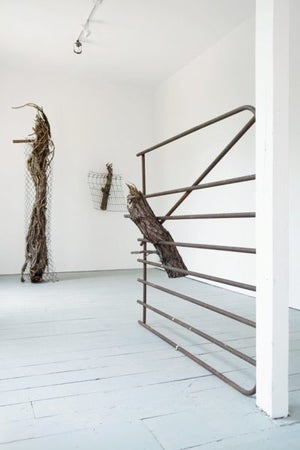
On view at Sigfrids, the works in Harlan’s exhibition “Trees” are all comprised of trunks and limbs which have grown together with portions of wire fencing, metal signs, and, in one case, a rusted gate.The six sculptures on display demonstrate the artist’s continued engagement with the readymade, although through refreshingly organic and time-worn found materials. Instead of being artificially fabricated by the artist, these works are simply removed from their original context in the wild and presented as artworks in a gallery. Harlan’s distinctly vernacular variation on the readymade complicates commonly drawn connections between modernism and urban environments, inserting an artistic tradition historically associated with European and American cities into the environs of rural Alabama and New England.
A visual rhythm present in the works’ installation in the gallery urges consideration of measured time, a theme reinforced in the rusting chain-link fencing and decaying wood. Dividing the gallery horizontally, the thick lines of a cattle gate ground the elements of the room like a staff tethers a flurry of musical notes, with a single, arm-length-long section of pine tree bulging through its metal bars. The two vertically-oriented works in “Trees”—a cropped tree trunk appearing to sprout a rusted sign from its side, and a tall pole enveloped in vines and wire— anchor either end of the cattle gate. Harlan’s three wall-hung pieces, comprised of rough-hewn tree limbs suspended in gridlike wire fencing, can appear as almost painterly assemblages or as archeological artifacts, suggesting the struggle between human effort and the unyielding passage of time.
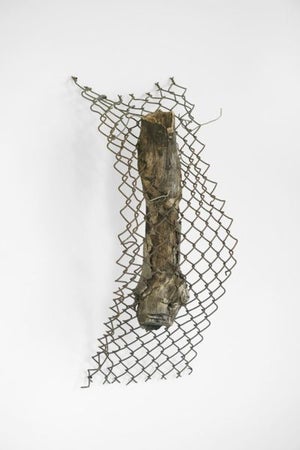
Nevertheless, Harlan’s works in “Trees” are, quite simply, tangled bits of wood and wire: neglected relics from your grandparents’ backyard or the landscape behind a roadside gas station. Harlan’s work is engaging precisely because of this casual familiarity, which establishes a comfortable foundation from which the viewer can explore the more esoteric associations implied by his sculptures.
In the adjacent gallery, Gainesville-born, Brooklyn-based artist Eleanor Ray presents a set of paintings that are keenly attuned to place and space. Like many of Ray’s recent oil paintings, the selection on view at Howard’s captures images from the artist’s recent travels; in this case, they primarily document landscapes in the American West. Of the seven tiny paintings on view, only four include any sort of architectural feature, but two others situate the viewer entirely indoors, a compelling departure for a painter who so often focuses on liminal spaces like doorways, windows, and corridors.
Microscopic portals to locales in Wyoming, Texas, and New Mexico, Ray’s paintings are generously spaced across the gallery. Given the compact nature of the painted panels, the show could feel sparse, but instead it feels each work has been given sufficient breathing room. Ray’s dry, loose application of paint is especially effective in rendering the dusty, expansive landscapes that dominate the background of most of the scenes. Where there are weightier objects like buildings or a rock formation, the brushstrokes becomes smoother and bolder, creating deep shadows that promise respite from the suggested heat. While Ray’s paintings don’t show figures, they invariably betray some evidence of people: in the man-made buildings, clearly, but also in the direct observational perspective from which Ray paints. The viewpoints are subjective and somewhat sentimental, captured with the tender haziness of a fond but imperfect memory.
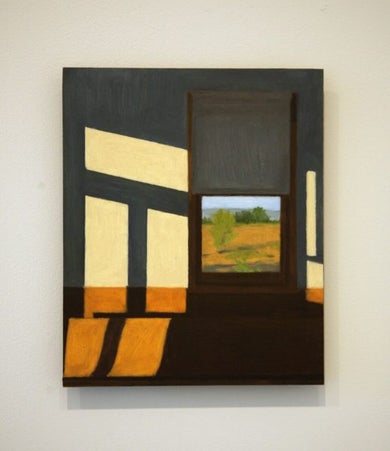
The standout of the show is the lusciously shadowed interior scene depicted in June Night, Wyoming, the only vertically oriented painting on view. Razor-edged light beams from an unseen window cut through the darkness enveloping the rest of the tightly cropped space, with the light warping over an otherwise obscured, brown horizontal plane, perhaps a church pew or bench. The painting shows a shade drawn halfway over a tall, vertical window, which frames sun-soaked shrubbery in the distance. While many of the other paintings feel somewhat static and offer little evidence of a particular time, June Night, Wyoming seems to capture a precious, almost tangible moment in paint.
Ray’s interest in space, light, and geometry reveals a tendency toward minimalist formality that, much like Harlan’s use of the readymade, might feel isolating were it not for her unwavering sense of subtle subjectivity. The prominence of Ray’s brushstroke and thoughtfully mixed colors in her consistently representational scenes imbues her paintings with a distinct idiosyncrasy that balances their visual formalism.

Works by Ree Morton (1936-1977) are tucked into a bizarre annex attached to Howard’s, a squat, elevated mini-hallway-to-nowhere lined with faux wood paneling. This surreal setting makes for an effective presentation of Morton’s work, which explores themes of domesticity, love, and child-rearing while incorporating and subverting traditionally feminine craft-based practices. Morton was an influential if lesser-known artist whose paintings and mixed-media installations during the 1970s are noted for embracing personal and emotional subject matter in a time when the austere, impersonal, and industrial qualities associated with minimalism were in critical favor. The show organized by Grennan in the Sigfrid’s/Howard’s annex is comprised of just two works from different points in the artist’s brief but impactful career.
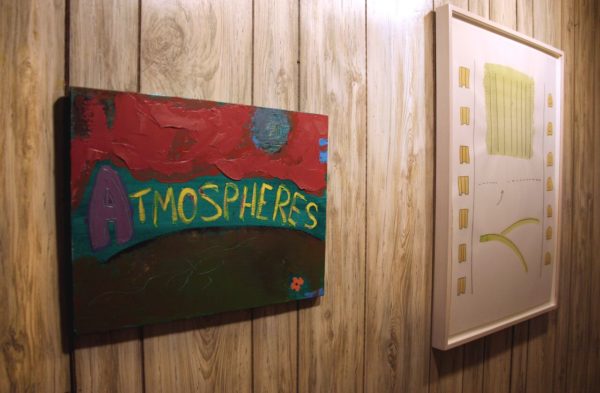
The painting from which the exhibition takes its name, Atmospheres, is part of the body of work that lead to Morton’s penultimate 1976 installation Signs of Love, which included elements such as ribbon-adorned yellow ladders leaning against gallery walls, picnic baskets overflowing with ribbons and roses resting on the floor, and curtain-draped landscapes painted with childlike abandon. The painting at Sigfrid’s/Howard’s is slightly more representational: gobs of garishly colored paint render a barely legible moonlit meadow, and the word “Atmospheres” is scrawled in dry paint across the horizon.
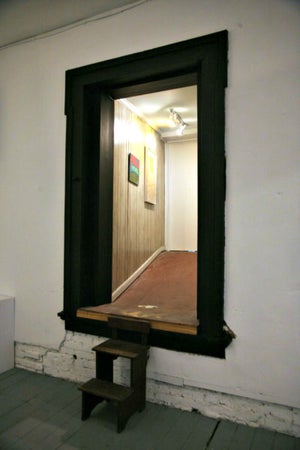
The other work by Morton on view, Untitled (Game Drawing), predates the artist’s decision to pursue her interest in the decorative as it relates to femininity and domesticity. Significantly more reserved in its composition than Atmospheres, this pencil-and-watercolor work on paper appears like a map for a game a child might invent on a summer afternoon. Two columns of yellow shapes line either side of a patch of green, below which dashed lines and an arrow suggest strategic movement.
Though it provides only a small glimpse into Morton’s body of work, the selection at Sigfrids/Howard’s offers a surprisingly potent introduction to the artist. The run of Atmospheres in Athens happens to coincide with the September 14 opening of “Ree Morton: The Plant That Heals May Also Poison” at ICA Philadelphia, the first retrospective of the artist’s work at an American museum in the near 40 years since her death.
All three exhibitions remain on view at Tif Sigfrids and Howard’s Art Gallery in Athens, Georgia, through Saturday, October 6.

